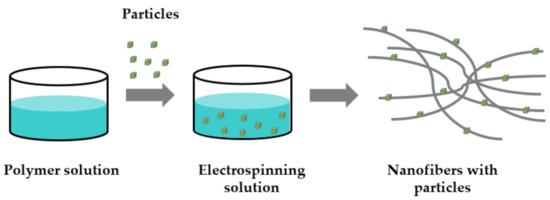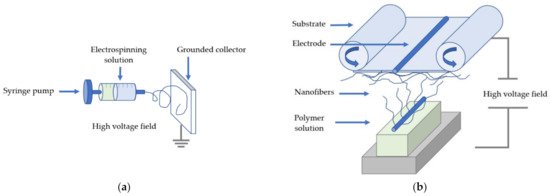Air pollution is one of the biggest health and environmental problems in the world and a huge threat to human health on a global scale. Due to the great impact of respiratory viral infections, chronic obstructive pulmonary disease, asthma, emphysema, lung disease, and heart disease, respiratory allergies are increasing significantly every year. Because of the special properties of electrospun nanofiber mats, e.g., large surface-to-volume ratio and low basis weight, uniform size, and nanoporous structure, nanofiber mats are the preferred choice for use in large-scale air filtration applications.
- air filtration
- electrospinning
- nanofibers mats
- nanofibers
1. Introduction
The atmosphere contains toxic particulate matter (PM) pollutants that are a mixture of particles, microorganisms, spores, toxic gases, heavy metal dusts, and organic pollutants, such as polycyclic aromatic hydrocarbons, benzene, and aerosol particles. In particular, small particles with a diameter of less than 2.5 μm pose a risk of penetrating deep into the bronchioles and human lungs and directly affecting lung breathing. Inhalation of these particles increases teratogenic, mutagenic and carcinogenic risk and leads to lung diseases, such as asthma, stroke, lung cancer, and heart disease [1][2][3][4][5][6][7][1,2,3,4,5,6,7]. Moreover, air pollutants greatly affect global health, and particulate matter (PM) plays a crucial role among these contaminants [8]. In many areas where air filtration is important, cleaning air and filtering out small air pollutants are very relevant approaches. In biotechnological field, the main requirements are the control of air pollutants, hazardous biological resources and aerosol particles. The automotive and aerospace industries are still looking for the quality and safety of a product aspect to minimize the amount of pollutants. However, the semiconductor industry has already adopted clean room technology to control and reduce product contamination [9][10][11][9,10,11]. In order to achieve high performance air filtration, different materials, including foams, carbon fibers, carbon nanotubes, and different types of fiber filters, such as standard glass, melt blown, cellulose and spunbond fibers, and the mixture of different materials were investigated aiming various air filtration applications [12][13][14][15][16][12,13,14,15,16]. Among them, fiber materials have become an important branch of filter materials due to the simplicity of processing and their porous structure. Technically, conventional filtration media like melt-blown and glass fiber cannot capture aerosol fine dust because the pore size of microfibers is relatively large and bacterial filtration is still limited [17]. Hence, these fibrous materials have limited efficiency in filtering the finest particles and are not suitable for all applications because of their large pore size structure and micro-scale fiber diameter [18][19][18,19]. Recently, some technologies have been developed to produce nanofibers, such as drawing process, sea-island spinning, and electrospinning, which are more successful in terms of filtering performances and capturing small particles [20][21][20,21].
Along with the development of nanofiber production technology, electrospinning is one of the most common and cost effective technologies due to the exceptional properties of nanofibers. The simplicity of use and versatility of using different bio-based and synthetic polymers, as well as blends, offers many advantages over conventional nonwoven manufacturing methods [22][23][24][25][22,23,24,25]. In addition, the uniformity of nanofibers and nanofiber mat structure with small fiber diameters and the associated ratio of large specific surface area to volume offer further advantages. The nanofiber mats include physical properties, such as high porosity and ultra-thin fiber diameters, as well as advanced chemical properties, such as permeability and porosity, associated with the geometric structure of the fibers [26][27][26,27]. Furthermore, it is possible to selectively produce and control the pore size between the nanofibers according to the application definition. In addition, by introducing the antimicrobial agents and particles and changing the morphology of the nanofiber mats into the nanoscale, well-cross-linked pore structure, all the conditions required for trapping fine particles can be met [28][29][30][31][32][28,29,30,31,32].
Furthermore, mechanical stability can be enhanced by embedding them in composites or adding more stable layers using 3D printing [33][34][33,34]. Other benefits include higher air permeability due to the slip-flow effect of nanofiber mats, which exhibit small pore size and high porosity, and good electrostatic effect, making it very suitable for air filtration applications. Nanofiber mats offer many advantages and have emerged as ideal candidates for suitable and efficient air filtration materials to purify the air. Since they can be effectively and inexpensively manufactured by electrospinning, they offer a promising strategy for efficient air filter materials [35][36][37][35,36,37]. According to the results of several research groups, nanofibers can easily be produced by electrospinning process from natural materials, such as polysaccharides, collagen, silk, cellulose, or synthetic polymers, such as polyacrylonitrile (PAN), poly(lactic acid) (PLA), acrylonitrile butadiene styrene (ABS), polyurethane (PU), polyvinyl alcohol (PVA), poly(ethylene glycol) (PEG), polystyrene (PS), polypropylene (PP), polyethylene terephthalate (PET), polyamide-6 (PA-6), etc. These and many other polymers are well known in the field of filter materials and are applied in air filter applications [38][39][40][38,39,40]. Many different nanofibers with defined properties can also be produced by adding particles and admixtures, and the number of variations is quite impressive. Despite that, many research studies have been committed to improve the air filter materials with high-performance air filters with high filtration efficiency to protect the environment.
2. Production Methods of Nanofibers Mats
Interest in electrospinning and nanofiber mats is increasing year by year, and various methods for fabricating nanofibers are described in the literature, including melt electrospinning, coaxial electrospinning, multi-jet electrospinning, needleless electrospinning, bubble electrospinning, electro-blowing, cylindrical porous hollow tube electrospinning, self-bundling electrospinning, and charge injection electrospinning [41]. Among all of these techniques, electrospinning is the most widely used and represents the simplest method for producing nanofibers with a large number of different polymers and admixtures [42][43][42,43]. Electrospinning is a simple technology used to produce continuous fine fibers or fiber mats with diameters in the nanometer range. The ultrathin fibers can be made from a variety of materials, such as polymer composites or melts, inorganic or inorganic/organic materials, possibly including ceramics, metallic nanoparticles, particulates, carbon nanotubes, etc., for defined applications [44][45][46][47][48][44,45,46,47,48]. Figure 1 shows the production process of nanofibers with particles by simply adding the particles to the electrospinning solution, mixing and producing nanofiber mats with embedded particles.

Figure 1.
Simple production of nanofibers with particles by adding particles to electrospinning solution.
All electrospinning techniques, such as the needle-based and the needle-free, are based on the same principle (Figure 2). These involve a high electric field applied to a polymer solution, which allows the fibers to form a Taylor cone at the electrode.

Figure 2.
Basic set-up for (
a
) needle based and (
b
) needleless electrospinning (Nanospider).
The standard needle-based electrospinning systems can be set up in two ways with vertical and horizontal orientation. Due to the working conditions, needleless electrospinning is divided into two types as rotating or stationary spinnerets. The spinnerets connected to a high voltage supply and a dosing unit for the spinning solution play the most important role for fiber quality and productivity. Nanofibers can easily be produced by adjustable control and a polymer solution reservoir (e.g., a syringe with a small diameter). The main parameters for both methods are the solution, the operating and the environmental parameters [49].
Needleless electrospinning is a self-organized process that allows electrospinning of nanofibers directly from an open liquid surface. During the whole process, a thin layer of a polymer solution is built up and rotated on the spinneret surface. This rotation produces conical peaks on the surface of the solution. At the same time, the electrical forces create Taylor cones and create nanofibers.
When preparing the electrospinning solution, the polymers become inserted into a solvent for dissolving and forming polymer electrospinning solution. Most of the polymers used to make nanofibers are dissolved in harmful to highly hazardous organic solvents. Some of them are highly flammable, toxic, harmful to the environment, need special waste disposal, and can cause harm to people, and pose high health and safety requirements [50]. Therefore, there is more demand and interest in “green electrospinning” and low-toxic solvents, such as dimethyl sulfoxide (DMSO), because it is easier to handle and does not cause any problem with disposal. This is why research groups use it. Especially, many researchers are interested in environmentally friendly electrospinning, in which low-toxic solvents and biopolymers are used to produce nanofibers [51][52][51,52].
